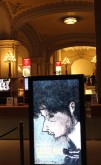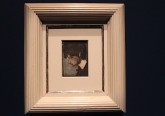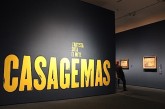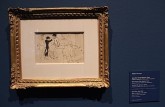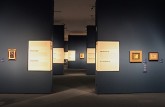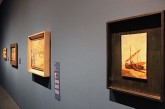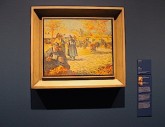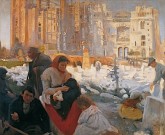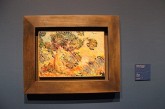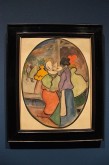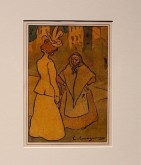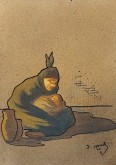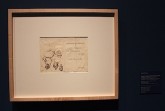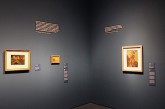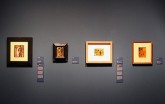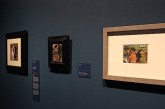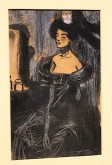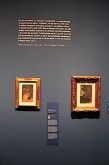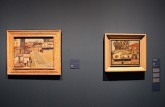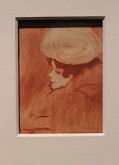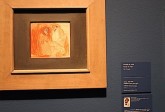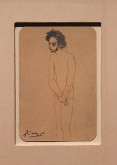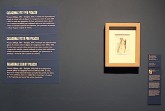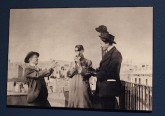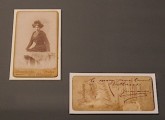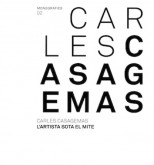The browser will either open the file, download it, or display a dialog.
Casagemas. L’artista sota el mite
Casagemas. El artista bajo el mito
Casagemas. The Artist Beneath the Myth
MNAC, Museu Nacional d’Art de Catalunya, Barcelona
October 31, 2014–February 22, 2015
Catalogue:
Carles Casagemas. L’artista sota el mite.
Carles Casagemas. El artista bajo el mito.
Eduard Vallès with essays by Francesc Fontbona, Artur Ramon, and Dolors Rodríguez.
Barcelona: Museu Nacional d’Art de Catalunya, 2014.
268 pp.; 169 color illus.; exhibitions list; checklist; bibliography.
€33
ISBN: 978-84-8043-273-3 [Catalan/Spanish, with English translation]
The first solo exhibition ever to be devoted to the Catalan artist Carles Casagemas (1880, Barcelona–1901, Paris) was unveiled at the National Art Museum of Catalonia (Museu Nacional d’Art de Catalunya, MNAC) on October 31, 2014. This show, which was on display at the Palau Nacional, or National Palace, in Barcelona’s Montjuïc area, occupied one of two spaces reserved for temporary exhibitions at MNAC, in the basement near the main entrance to the building. From this excellent position, the exhibition made itself known to museum visitors through light panels and posters that featured the only known self-portrait by Casagemas (fig. 1). One of the most outstanding pieces in the show itself, this pastel on paper alone provides a glimpse of some of the secrets behind an artistic and human personality that is further revealed in the exhibition, for this is a sombre, introspective self-portrait by an artist until now almost unknown (fig. 2).
Casagemas, friend of Picasso’s youth. Casagemas, the eccentric, depressive artist who committed suicide at the age of twenty. Casagemas, the inspiration behind La Vie, the most enigmatic and celebrated work in Picasso’s Blue Period. But who was Casagemas really? We have mentioned some of the preconceived ideas, generated and maintained by art history throughout the twentieth century, and which readily spring from the pen of anyone who chooses to write about Carles Casagemas. Always overshadowed by Picasso, Casagemas has been cited on countless occasions, but paradoxically, has never been the subject of in-depth study until this year.[1] As a result, many of the clichés about the accursed artist and the young bohemian would have probably continued to be our only references had not MNAC decided to do justice to an artist so often mentioned yet so little known.
Casagemas’s premature death, his extremely short career as an artist, and his proximity to Picasso, that great monster of twentieth-century art, largely explain why, until today, no solo exhibition had ever been devoted to Casagemas, a state of affairs that also helped to convert him into a legendary figure. That is why the show organised by MNAC, although small, is destined to be one of the most outstanding events in the current art exhibition season in Barcelona. The purpose of the show, which was curated by the art historian Eduard Vallès, is to dispel mistaken ideas and, above all, to vindicate and revive, as the title indicates, The Artist Beneath the Myth (fig. 3).
Thanks to Picasso’s biography, the memory of Casagemas has not been completely erased, but until now all mentions of him took the form of brief, rather murky, anecdotal references, which were all dwarfed by the transcendent oeuvre of the Málagan genius. We should remember that, until the opening of this exhibition, it could well be stated that portraits of Casagemas drawn and painted by Picasso were better known than works signed by Casagemas himself (fig. 4). Bearing this in mind, it would most certainly have been easy to present Casagemas from the viewpoint of Picasso’s world. However, this would have done nothing to free ourselves from the vague, imprecise image that has always accompanied the Catalan artist. That is why one of the great successes of this exhibition lies precisely in the fact that it does not succumb to Picasso, but rather places Casagemas, not only in the great Spanish painter’s orbit, but also within the context of the avant-garde movements of the day, linking him to some of the most powerful and outstanding artistic personalities in Barcelona at the time, such as Isidre Nonell i Monturiol and Joaquim Mir. After a rigorous process of research and selection of works had been completed, during which a large number of forgeries were discarded, the exhibition finally featured 38 out of around 50 pieces by Casagemas, which had been located. To be precise, the show includes seven oils and 31 drawings, presented in a space of modest, but adequate dimensions, some 200 square metres in area, delicately lighted to create an intimate, secluded, bluish, nocturnal environment (fig. 5). The small number of works on display is explained by the exhibition curator, Vallès: “Although it has always been commented that little work by Casagemas exists, the fact is that there are few artists by whom some fifty pieces have been preserved that were executed before they were twenty, the age at which he died. All one need do is glance at the catalogues raisonnés of several artists and count how many works they executed before this age (49).” In any case, the 38 pieces in the show are enough to provide visitors, for the first time, with a reliable overview of the young life and work of Carles Casagemas and to confirm his rightful place in art history.
Breaking from what would be probably the most conventional approach in an anthological solo exhibition devoted to a particular artist, Carles Casagemas: The Artist Beneath the Myth was not organised by chronological period. Rather, the show was arranged, in the main, according to thematic and stylistic criteria, to form seven sections that feature principally landscapes and portraits. No doubt this was because the artist’s short career—he was active for less than five years—did not leave many other options. However, the exhibition did open with Casagemas’s first known work, painted around 1896 or 1897 in Barcelona.
The first section was entitled A Broken Link: The Landscape, and in an allusion to its theme, included four landscapes painted in oil, three of them important discoveries. From the very beginning, then, the exhibition refuted the stereotypical clichés that define Casagemas as a portrait artist and caricaturist. The first work in the show was a conventional seascape that illustrated the important yet little known influence that the landscape painter Modest Urgell exercised over Casagemas’s early work (fig. 6).[2] However, the most surprising feature in this first exhibition section were the next three works. These pieces explained the title of the section, which suggested that the landscape genre was a link in an evolutionary chain that enabled Casagemas to feel free to explore, experiment, and grow as a painter. Several reviews and newspaper articles also speak of other landscapes that have unfortunately been lost or have not yet been located, but the first landscapes in this exhibition were sufficient in themselves to provide clear testimony to the skill of an artist who, we can now justly claim, has been unjustly disregarded.
The second work in the exhibition, entitled El mercat [The Market] comes from Pablo Picasso’s former collection and can be tentatively dated to around 1898 (fig. 7). While the first painting appears to be influenced by the work of Modest Urgell, a leading Catalan landscape artist in the late nineteenth century, this second piece clearly reveals similarities with works by the artists who formed the so-called Colla del Safrà, or Saffron Group, from 1896 to 1898. An example of this relation is a painting by Joaquim Mir entitled La catedral dels pobres [The Beggars Cathedral] reproduced on the wall label for the painting (81).[3] As was the case with other outstanding pieces in the exhibition, El mercat was accompanied by an explanatory and illustrated label with Mir’s painting (fig. 8). There can be no doubt that the fact that Casagemas’s creations in the exhibition were accompanied by notes and images helps to complete our understanding of his oeuvre and to round off the exhibition discourse.
Although several historians, including Alexandre Cirici, had already mentioned Casagemas as being a member of the Saffron Group, The Market is the first and only solid testimony to these probable youthful links with Joaquim Mir, Isidre Nonell, and Ramon Pichot.[4] At the same time, however, the painting can also be linked to the impressionist and pointillist works painted between 1892 and 1894 by one of the most outstanding Spanish artists of the time: Darío de Regoyos.[5]
While The Market is surprising for the theme chosen, for its luminous nature and the thick, sprightly, modern brushstrokes employed, the other two landscapes in this first section—Paisatge amb un gran arbre [Landscape with Big Tree] and Paisatge de costa [Coastal Landscape]—confirmed the discovery of a hitherto unknown Casagemas. Until now, one of the two landscapes, Landscape with a Big Tree, had always been attributed to an unknown artist despite the fact that, like The Market, the painting came from Pablo Picasso’s former collection and had been conserved in the Picasso Museum in Barcelona (fig. 9). In both cases, these oil paintings stand out for their thick, generous brushstrokes, executed from left to right (Casagemas was left-handed) to form daring landscapes that reflect a free, pre-Fauve use of color.
The second section contained nine works that revealed a Casagemas who was fully integrated into the Barcelona art of the late nineteenth century (fig. 10). These are genre paintings that adopt the Arabesque, colorist approaches of Modernisme images depicting popular characters and others in an unashamedly “local color” style (fig. 11). Nonetheless, we cannot fail to be surprised by the way in which Casagemas seizes any opportunity to work with and study different techniques, including so-called fregit (“fried”) drawing and the use of sprayed ink, similar to the ones by Nonell (figs. 12, 13) (87).[6] This is where we encounter the Casagemas that we perhaps most expect to find on first entering the show, in his best known facet as an artist who worked mainly in the genre of drawing, particularly in pastel and charcoal, including many works combined with watercolor.
The central sections in this exhibition contained several paintings and drawings that can be dated to the brief period from 1897 to 1899. These works reveal a multi-faceted Casagemas who interacted with his surroundings and, particularly, with the other artists who frequented Els Quatre Gats. At this café, besides meeting Pablo Picasso, with whom he would strike up a friendship and begin to share a studio in early 1900, Casagemas was also able to exchange ideas and projects with other artists, such as Miquel Utrillo, Ramon Pichot, Xavier Gosé, and Eveli Torrent. As Vallès clearly demonstrates in the catalogue, Casagemas was very close to the work of these artists, at certain times making it possible to establish clear dialogues between them with drawings, paintings, and illustrations that appeared in Barcelona, published or exhibited at the end of the century (91–99). On this point, we can also mention, particularly, his collaboration with Ramon Pichot, with whom Casagemas probably painted the curtain of the puppet theatre at Els Quatre Gats.[7]
The exhibition also illustrated the presence of Casagemas at the café in a specific section entitled Casagemas Exhibits at El Quatre Gats. This section contradicted what we had believed until now, that Casagemas had only one solo exhibition of drawings in the main salon at Els Quatre Gats from March 26 to April 10, 1900; Vallès has documented no fewer than three other occasions on which the artist presented pieces, shows that were reflected by comments in the press (fig. 14). Accordingly, the works in this section, which were all first hung on the walls of the popular and bohemian café, were exhibited here accompanied by excerpts from two reviews by Alfred Opisso and Frederic Pujulà, published in 1900 in La Vanguardia and Las Noticias, respectively (fig. 15). One of the best known reviews is that published by Opisso in La Vanguardia in April 1900, in which the art critic spoke of female portraits of “a perverse nature,” of landscapes that “reveal a pessimistic vision of nature, always sinister, unpleasant or menacing, and works full of vice, ugliness, unhappiness and desolation.”[8]
The vision that Opisso described in the pages of La Vanguardia in 1900 is one that we discover particularly in the second half of the exhibition. This part featured works that reflected the pessimistic outlook that characterises most of Casagemas’s production in general. Unlike the genre paintings and Art Nouveau-influenced works that can be dated back to 1898–1900, and which include those that Alexandre Cirici described as the ‘white wing of Modernism,’ having now reached the halfway stage in the exhibition, the visitor began to discover the so-called ‘black wing’ (fig. 16). Here we found drawings and pastels from around the years 1899 and 1900, when the friendship between Casagemas and Picasso began and intensified. Evidently, the two artists met in the spring of 1899 or thereabouts, and their growing friendship can be perceived in several works that clearly coincide in terms of theme, technique, and style. These works focus on the iconography of the couple and on the brothel; scenes that depict the slums of Barcelona at the turn of the twentieth century and which are imbued with a certain social critique (fig. 17). No doubt the most paradigmatic example is the pastel Casa de cites [“Brothel”]. As the wall notes make clear, this work, acquired by MNAC in 2009, has many similarities with Picasso’s The Divan (1899–1900, Museu Picasso, Barcelona).
Some of the female portraits of a “perverse nature,” as described by Alfred Opisso, were among those presented in a specific section in the exhibition entitled Una inquietant feminitat [A Disturbing Femininity]. Indisputably, women now become a key theme in the work of Casagemas, featuring perturbing feminine figures surrounded by spectres that suggest the artist’s inner world, his visions, phantoms, and dreams (fig. 18). On this point, besides presenting ‘lumpen’ Barcelona, it would have been useful also to have referred to decadence as a central theme at the turn of the century, one that took root in the Barcelona of Casagemas. Observing these works by Casagemas, we recall such pieces as Joséphin Péladan’s Salon de la Rose + Croix, which Santiago Rusiñol had seen and described on the pages of La Vanguardia some years previously, as well as countless other decadent works by artists from his circle, such as Pichot, Gual, Nonell, and Rusiñol himself.[9] On this point, we should remember, as the catalogue states, that Casagemas came from a cultured family with artistic and literary interests and, therefore, had direct access to the European symbolist and decadent aesthetics of such writers as Paul Verlaine and Maruice Maeterlinck (58).[10] Here, we should mention, too, that one of the most exciting discoveries made by Vallès for this exhibition is a previously lost poem by Casagemas that was published in the Eco de Sitges on 21 January 1900. Entitled Amor gris [Grey Love], this enigmatic and passionate poem expresses his graphic work in words (fig. 19).[11]
Although the different sections that form this exhibition were not organised with a clearly chronological purpose, as we advance, we will discover an ever more complex artist: from the landscape, we move on to bourgeois and genre scenes and, subsequently, to the gradual revelation of Casagemas’s most intimate and irrational fears and obsessions. It is here that we finally reach the section devoted to the artist’s final days, spent between Paris, Barcelona, and Málaga in 1900 and 1901.
Casagemas’s visit to Picasso in Montmartre from October to December 1900 is probably one of the best known periods in his short life thanks to the letters he wrote to Ramon Raventós and to the memoirs of Picasso and Catalan friends like Manuel Pallarès.[12] Until now, only a single oil painting by Casagemas was known, one of several Montmartre scenes, which he painted and sold, probably at the request of tourists visiting the French capital on the occasion of the World’s Fair.[13] This oil, executed in a more conventional style than the landscapes or the more personal pastels and drawings, is now joined by another similar painting, never before exhibited, from Pablo Picasso’s former collection (fig. 20). In any case, it is unlikely that Casagemas was particularly prolific in his production of works during his stay in Paris.
Each section in the exhibition provides fresh information, works, images, and news stories that enrich our understanding of Casagemas’s life and work. It is well known that, during his stay in Paris, Casagemas fell in love with Germaine, the future wife of the Catalan painter Ramon Pichot, of whom he made several portraits (fig. 21). It is also well known that the affair did not turn out as hoped and that Germaine, unsatisfied, finally turned him down. Towards the end of the year, Casagemas and Picasso returned to Barcelona for Christmas before travelling on to spend the New Year in Málaga.[14] But what was Casagemas doing in Málaga with Picasso? The reason always given was that he had accompanied Picasso to get away from his short and difficult relationship with Germaine. However, a more plausible hypothesis can now be suggested.
As Manuel Pallarès notes in his memoirs, Picasso travelled to Málaga towards the end of the year in order to persuade his family to buy him out of military service. It is on this point that Eduard Vallès suggests that Casagemas may have accompanied his friend, with the idea that the two might then go on to Madrid to launch a new joint project: the magazine Arte Joven [Young Art]. However, on January 28, while they were still in Málaga, Casagemas and Picasso fell into a very violent argument, after which the latter decided to abandon his friend and travel to Madrid on his own (fig. 22). All this leads to an important reinterpretation of events during the last few months of Casagemas’s life. Based on the detailed descriptions of the days following the artist’s suicide, published in the French press and now discovered, Vallès suggests the possibility that, before making his final journey to Paris, Casagemas may have gone to Madrid to attempt to revive that joint project with Picasso: “The theory I put forward, based on new information, contends that instead of going to Paris, as he had anticipated, Casagemas traveled from Barcelona to Madrid to meet up with Picasso and Soler. But given Picasso’s character, the latter would have utterly cold-shouldered him and Casagemas would have continued on his way to Paris. This hypothesis is supported by dates: between January 28, when he wrote the letter, and February 17, when he committed suicide, there was sufficient time for him to undertake this journey. (. . .) His documented aversion to his family leads us to rule out the possibility of his having remained in Barcelona, and had he not gone to Madrid, he would have arrived earlier in Paris (198).” After this, the dramatic final act in Paris is well known: several versions exist, but, basically, Casagemas committed suicide at the Hippodrome restaurant on February 17, 1901. On that day, Casagemas died and the legends about his suicide and about his links with Picasso were first born.
Until now, the image that we possessed of Casagemas had been constructed principally around the work of Picasso, who made portraits of his friend on more than thirty occasions (fig. 23).[15] It is unsurprising, then, that, although a single photograph and a small self-portrait are known, Picasso’s works should have been, until the present, the main source used to make in-depth studies of Casagemas. Precisely so as not to draw attention away from our artist, towards the end of the exhibition, there were just three minor drawings by Picasso. The pieces selected are rarely reproduced drawings that help to complete our image of Casagemas. They were accompanied by a sketch by Casagemas himself. This piece shows a man sitting, his back turned, identified as José Ruiz Blasco, Pablo Picasso’s father (fig. 24). This drawing is interesting, not so much due to its similarities with the portraits that Picasso made of his father, as because it shows how close Casagemas had become to Picasso’s family. Finally, to complete this external gaze, the exhibition closed with a section devoted to documentary material, including literary texts, letters, and photographs (figs. 25, 26). All this is accompanied by an interactive installation with a touch screen, entitled Galaxia Casagemas. This “Casagemas Galaxy” enables us to browse more than 100 entries to learn new or little known facts about different aspects of Casagemas’s life and work (his formation, his family, his atelier, his artistic circle, reviews, his works, and historic collectors of them) (fig. 27).
The exhibition can be seen as something of a delicatessen show: it takes a fresh look at Carles Casagemas, presenting surprising works, suggesting new uncertainties, opening up new hypotheses and filling in certain biographical gaps by providing a large amount of invaluable unpublished material. The fact that Casagemas is presented here in isolation from Picasso enables the focus to be cast on a highly original and personal oeuvre that shines in its own light and illustrates the spirit of the times, with all the tensions that marked the period. In this respect, the catalogue—which will soon be available in English and French, as well as in Catalan and Spanish—is an absolutely indispensable publication, providing a glimpse of the depth and range of the research that is synthesised in the exhibition itself (fig. 28). Like most of the Picassian studies that Eduard Vallès has published in recent years, this show and its accompanying catalogue are destined to become key references for all those who study Casagemas. Congratulations are due, therefore, to both the curator and the National Art Museum of Catalonia (MNAC) for launching a long awaited new line of rigorously prepared exhibitions and publications aimed at reappraising Catalan artists and for raising awareness about research that is of great interest to both local and international audiences. Until today, the figure of Casagemas had been constructed under the shadow and shelter of Picasso. Now, for the first time, it is Casagemas who sheds new light on the work of Picasso. At last, it seems, justice has been done, and Casagemas has been rescued from oblivion. It is to be hoped that, in the future, based on these solid foundations, constant research and new discoveries will present an ever more complete and accurate image of the young artist beneath the myth.
Ricard Bru i Turull
ricardbru[at]bcn.cat
[1] Casagemas is mentioned in practically all biographies of Picasso. We also find interesting comments on his life in the memoirs and notes left by several of his contemporaries, such as Manolo Hugué, Josep Rocarol, Manuel Pallarès, and Jaume Sabartés. However, until now, there had been only one publication that, in introductory, general but nonetheless invaluable fashion, had given us a glimpse of Carles Casagemas. We refer to the catalogue published to accompany the exhibition Casagemas i el seu temps [Casagemas and His Times], presented at the Sala Daedalus in Barcelona in 1979. Besides this short but valuable publication, the catalogue to the exhibition recently unveiled at the Museu Nacional d’Art de Catalunya (MNAC) also includes a state of the question with regard to the scant historiography devoted to the life and work of Carles Casagemas. We should also mention that on October 3, 2014, parallel to the exhibition, a doctoral thesis was presented that was also devoted exclusively to this artist: Dolors Rodríguez Roig, “Carles Casagemas Coll. Vida i obra d’un bohemi burgès” [Carles Casagemas Coll. Life and Work of a Bourgeois Bohemian] (Barcelona: Autonomous University of Barcelona, 2014) (http://carlescasagemas.cat). The exhibition catalogue features a summary of Rodríguez Roig’s study, whilst the entire doctoral thesis will soon also be available online (www.tdx.cat).
[2] Casagemas is not known to have attended art school, and the only references to his training, provided by Josep Palau i Fabre in 1971 in conversations with Joan Vidal Ventosa and Picasso himself, suggest that he studied under the set designer Felix Urgellès. However, it is possible that Casagemas may have come into contact with Modest Urgell through Fèlix Urgellès himself. Besides this landscape, two other small oils are conserved. Unfortunately, it was not possible to exhibit or reproduce these particular works due to the express wish of the owner. However, the pieces do illustrate the link between the work of Modest Urgell and Casagemas’s earliest paintings. Josep Palau i Fabre, Picasso i els seus amics catalans (Barcelona: Editorial Aedos, 1971), 76.
[3] We should remember that The Beggars Cathedral, one of Joaquim Mir’s best loved and most acclaimed youthful works, was exhibited at Els Quatre Gats, the café that Carles Casagemas also began to frequent towards the end of the century. In this regard, the exhibition catalogue also enriches our reading of this work with other references, such as, for example, Joaquim Mir’s oil painting El venedor de taronges [The Orange Seller], 1896, Buxeres Pujol-Soliano Collection.
[4] Alexandre Cirici, El arte modernista catalán (Barcelona: Aymat, 1951), 356.
[5] The Market reminds us particularly of other genre paintings on similar themes, such as Regoyos’s Market, Compostela (1892, private collection). We should remember that Regoyos took part in the Second General Exhibition of Fine Arts in Barcelona in 1894, showing four works that generated considerable impact and acclaim in the Catalan capital, alongside such artists as Rusiñol, Casas, Brull, and Pichot. Moreover, in 1898, Regoyos established his residence in Barcelona and embarked on artistic activity that revolved around the magazine Luz and the Els Quatre Gats café, that is to say, precisely the circles that Casagemas also frequented. Juan San Nicolas, Darío de Regoyos (1857–1913). La aventura impressionista (Bilbao: Museo de Bellas Artes de Bilbao, 2014), 238–42.
[6] According to legend, artists like Nonell, Picasso and Casagemas produced these works by frying the paper in boiling oil in a pan. In truth, though, we do not know what technique they really used. Although the secret of the “fried” technique remains a mystery, the exhibition catalogue suggests a new hypothesis based on the memoirs of Josep Rocarol, a regular at Els Quatre Gats.
[7] The source of this reference, often forgotten, and noted also by Isabel Fabregat in her doctoral thesis on Ramon Pichot, are the memoirs of Josep Rocarol. Isabel Fabregat Martín, Ramon Pichot Gironès: Barcelona, 1871–París, 1925 (Barcelona: Universitat de Barcelona, 2011), 63. Josep Rocarol, Memòries de Josep Rocarol i Faura, (Barcelona: Editorial Hacer, 1999), 37.
[8] Alfredo Opisso, “Exposición Casagemas en los IV Gats,” La Vanguardia, no. 6088 (April 18, 1900): 5.
[9] Santiago Rusiñol, “La orden de la Rose-Croix. Desde el molino,” La Vanguardia, no. 3179 (March 18, 1892): 4. In the case of Catalonia, recent studies by Irene Gras demonstrate the links and interrelations between art and literature, which are also suggested in the exhibition devoted to Casagemas. In fact, Richardson had already presented Casagemas as an artist who struggled to become decadent. Irene Gras Valero, El Decadentisme a Catalunya: Interrelacions entre art i literatura, (Barcelona: Universitat de Barcelona, 2009), 252. John Richardson and Marilyn McCully, Picasso. Una biografía. 1881–1906 (Madrid: Alianza Editorial, 1991), 118.
[10] See also Richardson and McCully, Picasso. Una biografía. 1881–1906, 121.
[11] These verses contained poetic images that spoke of the difficulties in love that would lead him to attempt suicide and, inevitably, to his death a few months later. Vallès, 165.
[12] It is thanks to Casagemas’s friendship with Picasso that, from 1900, there is an increase in information and news items conserved and known about about the Catalan artist.
[13] This is the painting that motivated the celebration of the exhibition at the Sala Daedalus gallery in Barcelona in 1979, and the publication of the accompanying catalogue.
[14] Eduard Vallès turns to the memoirs of Manuel Pallarès, often forgotten, though conserved at the Palau Foundation in Caldes D’Estrac, due to their documentary value in reconstructing this period in the lives of both Casagemas and Picasso. We should remember that, thanks to his friendship with Casagemas and Picasso, as well as with Germaine, Pallarès was a first-hand witness to the events discussed here.
[15] Casasegmas was probably the Catalan artist most frequently portrayed by Picasso. Eduard Vallès, Picasso. Amics catalans de joventut (Horta de Sant Joan: Centre Picasso d’Orta, 2009), 112.


